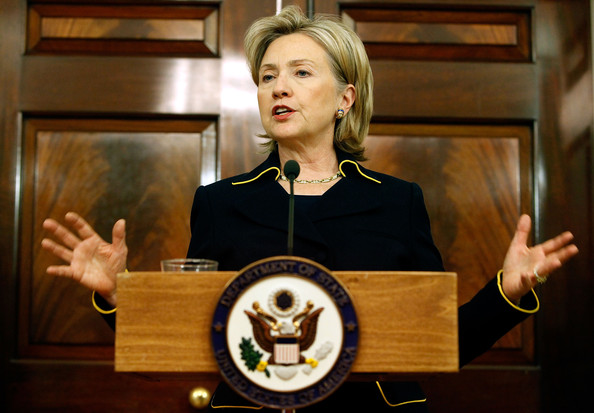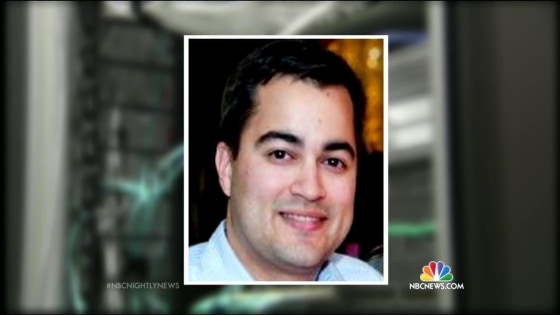The date was August 10, 2010. The subject of the email was “OIG inspection of Embassy Nairobi and Somalia Unit.” Sender: Cheryl Mills, Secretary of State Clinton’s Chief of Staff. Recipient: Hillary Clinton. Here is the irony. Among criticisms Mills reports against the U.S. ambassador in Nairobi are the following:
“He made clear his disagreement with Washington policy decisions and directives concerning the safe-havening in Nairobi of families of Department employees who volunteered to serve in extreme hardship posts; the creation of a freestanding Somalia Unit; and the nonuse of commercial email for official government business, including Sensitive But Unclassified information.” [emphasis added]
“The Ambassador does not read classified front channel messages and has not established a system to have his staff screen incoming cables relevant to Kenya and U.S. interests in the region.”

Secretary of State Clinton
Note that this OIG (inspector general) report about a U.S. embassy was conveyed and discussed in personal emails, before being posted on the OIG web site. Mills sent it via the commercial email system set up by Hillary Clinton in the private home shared with her spouse. The full document dump for emails released most recently is linked here. (A quick search using the word redacted turns up this email alone, in duplicate.)
News outlets have noted that this end-of-year release is incomplete and is less searchable than the previous releases. A series of solid articles by Rosalind Helderman and others in WaPo in 2015 chronicled some previous inconsistencies in Clinton’s explanations about the emails, their partial release, the emails withheld by Clinton, and the private server. See here and here and here, among others. A number of the emails refer to Benghazi or to Libya, but none date from 2012 or after the Benghazi attacks. Apparently the public will have to wait until farther into 2016 to see what if any mention Benghazi drew in Secretary of State Clinton’s email correspondence. Meanwhile, some personnel were frowned upon Dolores Umbridge-style. (The emails reveal close if not snitty attention to Joe Biden, a topic for separate discussion.)
As I wrote previously, even a quick search of the emails released shows that while using her home email set-up, Clinton was aware that security was an issue. In numerous emails, she referenced the fact that her email server was different from secure set-ups, and she nonetheless conveyed details of schedule and travel, etc., in the emails. These were messages sent by her, over two or more years, as well as messages sent to her.

Clinton staffer set up private email server
Thus it is as said ironic that a top Clinton crony targeted an ambassador for using commercial email. The ambassador in question was Michael E. Ranneberger, a career foreign service officer rather than a political appointee. Ranneberger had served under both the Bush and the Obama administrations. There are mixed views about U.S.-Kenya relations, which have in any case had a mixed history. But there seems no doubt that the ambassador was active and engaged.
Perhaps it is pointless to speculate about motive. However, there are two realistic conclusions. One is that the use of commercial email could not have been that damning. Clinton was doing the same herself. The other is that the Clintons have no track record of rewarding benevolence. They tend to distrust it. Perhaps there was a deeper rub in the ambassador’s conduct:
“The Ambassador’s initiative to redirect programming for nearly S-550 million in U.S. health assistance, while well -intentioned, has proven disruptive and created confusion about its relationship to existing programs. He announced to the Kenyans the establishment of a new unfunded program, called Let’s Live, with the unrealistic aim of reducing by 50 percent in 1 year Kenya’s premature mortality rates for infants, mothers, and noncommunicable diseases.”
Sounds as though Ambassador Ranneberger was a little too highly motivated, and perhaps too willing to be inspired by the new President Obama. Too bad. He sounds like a good man, in hindsight.
Speaking of relationships, if the OIG objected to the use of commercial email, it would be interesting to know what kind of relationship the OIG had with Secretary of State Clinton.
Text in full below:
UNCLASSIFIED U.S. Department of State Case No. F-2014-20439 Doc No. C05792759 Date: 12/31/2015 RELEASE IN FULL From: Sent: To: Subject: Attachments: Mills, Cheryl D <MillsCD@state.gov>Friday, August 10, 2012 8:17 AM Fw: OIG inspection of Embassy Nairobi and Somalia Unit Embassy Nairobi redacted ISP-I-12-38A.pdf Fyi From: Kennedy, Patrick F Sent: Friday, August 10, 2012 08:01 AM To: Mills, Cheryl D Cc: Carson, Johnnie; Thomas-Greenfield, Linda(MS); Nuland, Victoria J; Hammer, Michael A Subject: FW: OIG inspection of Embassy Nairobi and Somalia Unit The “Inspection of Embassy Nairobi, Kenya (Report Number ISP-I-12-38A, August 2012)” will be put up on the OIG web site some time Friday morning, WDC time Included in the Embassy Nairobi report are the following key findings [Edited by PK to list only those relevant to Amb.]:
- The Ambassador has lost the respect and confidence of the staff to lead the mission. Of more than 80 chiefs of mission inspected in recent cycles, the Ambassador ranked last for interpersonal relations, next to last on both managerial skill and attention to morale, and third from last in his overall scores from surveys of mission members. The inspectors found no reason to question these assessments; the Ambassador’s leadership to date has been divisive andineffeah7e.
- The Ambassador has damaged the cohesion of Embassy Nairobi’s country team by underscoring differences _ between offices working directly with Kenya and those with regional responsibilities. Country team members, particularly those from other agencies, relied on the recently departed deputy chief of mission to maintain a sense of common purpose at Embassy Nairobi. Unless corrected there is a risk that the country team will become dysfunctional. The Ambassador needs to broaden his understanding of why various agencies are part of his mission, cease avoiding contact with them, and work with the assistance of a senior Department of State (Department) official and the next deputy chief of mission to restore country team harmony.
- The Ambassador’s efforts to develop and focus the mission’s work around what he calls “mission essential tasks” have consumed considerable staff time and produced documents of unclear status and almost no value to the Department in approving priorities and assigning resources. His efforts have also created confusion about the relevance of the embassy’s annual Mission Resource Request (MRR). The Office of Inspector General (01G) team agreed with embassy staff that the mission essential task process added no real value to the management of the embassy.
- The Ambassador’s greatest weakness is his reluctance to accept clear-cut U.S. Government decisions. He made clear his disagreement with Washington policy decisions and directives concerning the safe-havening in Nairobi of families of Department employees who volunteered to serve in extreme hardship posts; the creation of a freestanding Somalia Unit; and the nonuse of commercial email for official government business, including Sensitive But Unclassified information. Notwithstanding his talk about the importance of mission staff doing the right thing, the Ambassador by deed or word has encouraged it to do the opposite. The Ambassador does not read classified front channel messages and has not established a system to. have his staff screen incoming cables relevant to Kenya and U.S. interests in the region.
UNCLASSIFIED U.S. Department of State Case No. F-2014-20439 Doc No. C05792759 Date: 12/31/2015 UNCLASSIFIED U.S. Department of State Case No. F-2014-20439 Doc No. C05792759 Date: 12/31/2015
- The Ambassador’s initiative to redirect programming for nearly S-550 million in U.S. health assistance, while well -intentioned, has proven disruptive and created confusion about its relationship to existing programs. He announced to the Kenyans the establishment of a new unfunded program, called Let’s Live, with the unrealistic aim of reducing by 50 percent in 1 year Kenya’s premature mortality rates for infants, mothers, and noncommunicable diseases.
